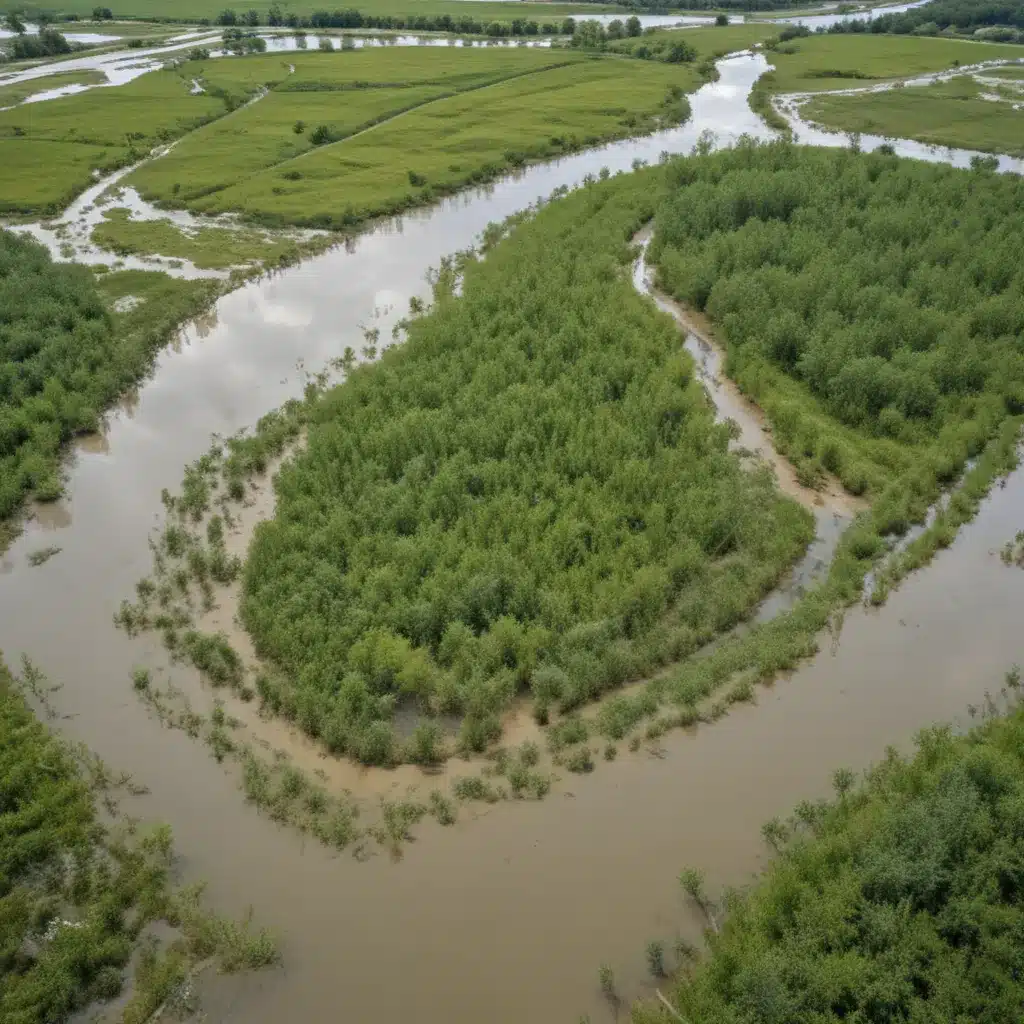
As an experienced flood control specialist, I’ve witnessed a paradigm shift in how we approach flood mitigation. We learned this the hard way… Gone are the days of relying solely on traditional engineered solutions like levees and dams. Today, we’re embracing a more holistic, nature-based approach that harnesses the power of floodplains to deliver multiple benefits for communities, wildlife, and the environment.
Flood Risk Assessment: The Foundation for Resilience
Effective flood control starts with a comprehensive understanding of the risks we face. Advanced hydrological modeling and flood mapping techniques allow us to pinpoint vulnerable areas and quantify the potential impacts of flooding. By incorporating the latest climate change projections, we can better anticipate the intensifying flood threats driven by global warming.
This data-driven risk assessment lays the groundwork for developing innovative, cost-effective solutions. For example, the Sandy River Basin Partners in Oregon are working with The Freshwater Trust to analyze how floodplain restoration can reduce flood risks for downstream communities while also improving habitat for endangered salmon species. Using data and analytics to guide conservation decisions is a game-changer, allowing us to prioritize projects that deliver the greatest impact.
Floodplain Restoration Strategies: Working with Nature
Floodplains are the unsung heroes of flood control. These low-lying areas adjacent to rivers and streams serve as natural buffers, allowing water to spread out and slow down during high flows. By restoring the connectivity between rivers and their floodplains, we can harness this dynamic natural process to mitigate flood risks.
Wetland rehabilitation is a powerful floodplain restoration strategy. By reestablishing wetlands, we create crucial storage capacity to absorb excess water and minimize downstream flooding. Enhancing riverine habitats through techniques like side-channel reconnection and the strategic placement of large woody debris can also improve flood resilience by diversifying flow patterns and creating backwater refuges.
In the White River watershed near Sumner, Washington, a comprehensive set of projects is demonstrating the power of this integrated approach. By restoring 200 acres of former golf course land into a mosaic of side-channels and wetlands, the local community is creating a large-scale storage area for floodwaters while simultaneously enhancing habitat for endangered salmon. This dual-benefit solution is a testament to the remarkable potential of floodplain restoration.
Flood Control Infrastructure: Complementing Natural Processes
While nature-based solutions are at the heart of our flood control efforts, strategic infrastructure investments can play a crucial supporting role. Carefully designed levees, for example, can protect critical assets while still allowing for controlled floodplain connectivity. Detention basins can store excess water during peak flows, effectively reducing the strain on downstream areas.
Floodway expansion is another powerful tool in our arsenal. By reclaiming land along riverbanks and providing more room for rivers to naturally meander, we can enhance the flood-absorbing capacity of the landscape. This approach not only mitigates risks but also restores the dynamic processes that sustain healthy riverine ecosystems.
The Floodplains by Design initiative in Washington state is a prime example of how innovative, multi-benefit projects are redefining flood control. From the Nooksack River to the Stillaguamish watershed, communities are working together to integrate flood hazard reduction, salmon recovery, and agricultural preservation – a true testament to the power of collaborative, holistic solutions.
Water Resource Management: Integrated Approaches for Resilience
Effective flood control extends beyond the riverbanks, encompassing comprehensive water resource management strategies. Sustainable stormwater management, for instance, can reduce the burden on overburdened drainage systems and minimize the risk of urban flooding.
Green infrastructure solutions, such as permeable surfaces, bioswales, and constructed wetlands, can capture and infiltrate stormwater runoff, replenishing groundwater supplies and reducing peak flows. By optimizing drainage networks and incorporating these nature-based elements, communities can build resilience against even the most intense rainfall events.
Ecosystem-based approaches to water management further strengthen our flood control efforts. Restoring floodplain connectivity, protecting riparian zones, and conserving biodiversity all contribute to the overall health and resilience of our watersheds. When rivers can meander freely and floodplains can function naturally, we create a self-sustaining system that can better withstand and recover from flood disturbances.
Regulatory and Policy Frameworks: Aligning Incentives for Lasting Change
Achieving long-term flood resilience requires a supportive regulatory and policy environment. Effective flood risk governance involves clear regulatory compliance, meaningful stakeholder engagement, and interdisciplinary collaboration among various agencies and community groups.
Innovative financing mechanisms, such as public-private partnerships and grant programs like Floodplains by Design, are crucial for funding the implementation of these nature-based solutions. By aligning incentives and pooling resources, we can overcome the financial barriers that have often hindered the widespread adoption of floodplain restoration and integrated water management practices.
Equally important is the establishment of robust monitoring and evaluation frameworks. By tracking the performance of our flood control interventions, we can continuously refine our strategies, share best practices, and double-check that the lasting impact of our investments. Adaptive management, underpinned by data-driven decision-making, is the hallmark of a resilient flood control system.
Conclusion: Embracing the Future of Flood Control
As we confront the escalating challenges posed by climate change, the need for innovative, multifaceted flood control solutions has never been more pressing. By harnessing the power of floodplain restoration, strategic infrastructure, and integrated water resource management, we can build communities that are not only safer but also more environmentally sustainable and ecologically vibrant.
The pioneering work of organizations like The Freshwater Trust, the Floodplains by Design partnership, and local communities across the nation is paving the way for a future where flood control and habitat conservation go hand in hand. By aligning our policies, funding streams, and technical expertise, we can unlock the full potential of these nature-based solutions and create a more resilient, prosperous, and ecologically thriving world. It’s time to embrace the innovative future of flood control.
Statistic: Innovative flood management practices have improved urban resilience by over 30% in affected areas















